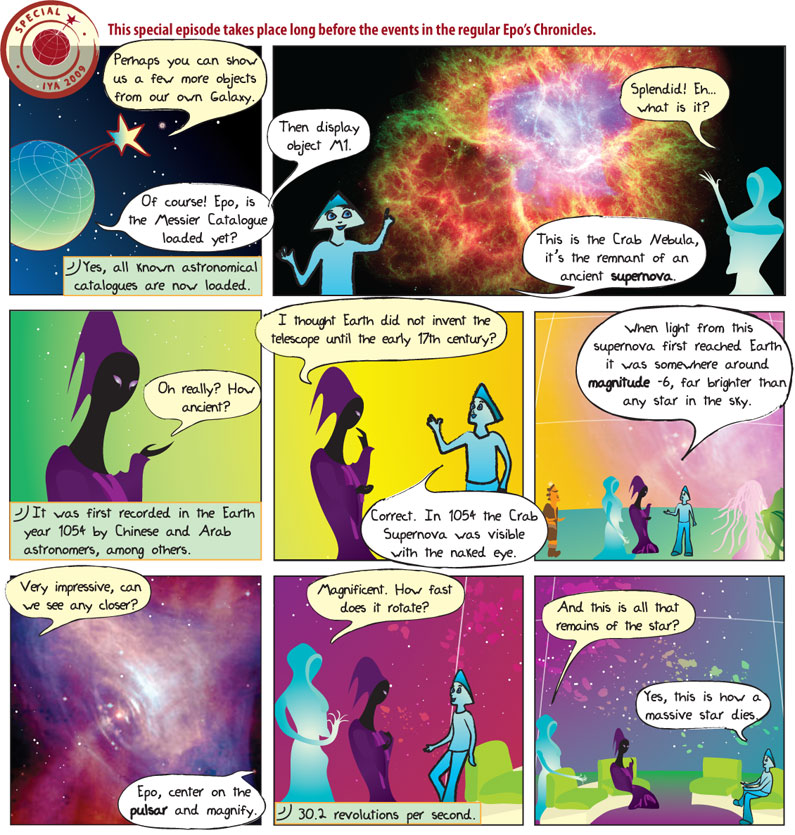
Comic Transcript
Panel 1.
Ambassador 1: Perhaps you can show us a few more objects from our own Galaxy.
Alkina: Of course! Epo, is the Messier Catalogue loaded yet?
Epo: Yes, all known astronomical catalogues are now loaded.
Panel 2.
Alkina: Then display object M1.
Ambassador 1: Splendid! Eh… what is it?
Alkina: This is the Crab Nebula, it’s the remnant of an ancient supernova.
Panel 3.
Ambassador 2: Oh really? How ancient?
Epo: It was first recorded in the Earth year 1054 by Chinese and Arab astronomers, among others.
Panel 4.
Ambassador 2: I thought Earth did not invent the telescope until the early 17th century?
Alkina: Correct. In 1054 the Crab Supernova was visible with the naked eye.
Panel 5.
Alkina: When light from this supernova first reached Earth it was somewhere around magnitude -6, far brighter than any star in the sky.
Panel 6.
Ambassador 1: Very impressive, can we see any closer?
Alkina: Epo, center on the pulsar and magnify.
Panel 7.
Ambassador 1: Magnificent. How fast does it rotate?
Epo: 30.2 revolutions per second.
Panel 8.
Ambassador 1: And this is all that remains of the star?
Alkina: Yes, this is how a massive star dies.
What does it mean?
Supernova – The explosion of a star near the end of its lifetime, as it runs out of nuclear fuel in its core. Only massive stars can become supernovae. Supernova explosions are so bright they can be easily observed in other galaxies.
Pulsar – is a spinning neutron star with a very strong magnetic field, which emits a beam of electromagnetic radiation. This makes the star appear to pulse as the electromagnetic beam moves in and out of our line of sight, similar to how a lighthouse works.
Magnitude – Astronomers measure how bright an object is in terms of its apparent magnitude. Counter intuitively, the brighter an object is, the lower its magnitude. A first magnitude star is about 2.5 times as bright as a second magnitude star, and so on. The brightest object in the sky is, of course, the Sun; with a magnitude of -26.73. The full moon is -12.6, and with the naked eye we can see all the way down to about a magnitude of 6.
Is that all?
Fact Sheet: Crab Nebula
 Location: Constellation Taurus.
Location: Constellation Taurus.
Distance from Earth: 6,500 lightyears.
Apparent Magnitude: 8.4.
Diameter: 11 lightyears.
More information:
The Crab Nebula is a cloud of expanding gasses set in motion when a star went supernova. In the year 1054, when light from the supernova first reached Earth, this object was very bright. Records from that time indicate that it was visible for 23 days during daylight and 653 days in the night sky. At that time, the Crab supernova was around a magnitude of -6. Today, the gasses have expanded and cooled, and the nebula has a magnitude of 8.4, no longer visible to the naked eye. Charles Messier first noticed this object in 1758 while searching for Halley’s Comet, and its discovery served as his impetus to create his now famous catalogue. This is why the Crab Nebula bears the distinction of being named M1.
Apparent magnitude – Wikipedia article on magnitude with list of various objects and their magnitudes.
Supernova Educator Unit – The SSU E/PO group has developed a set of activities and background materials for the Supernova Educator Unit.
